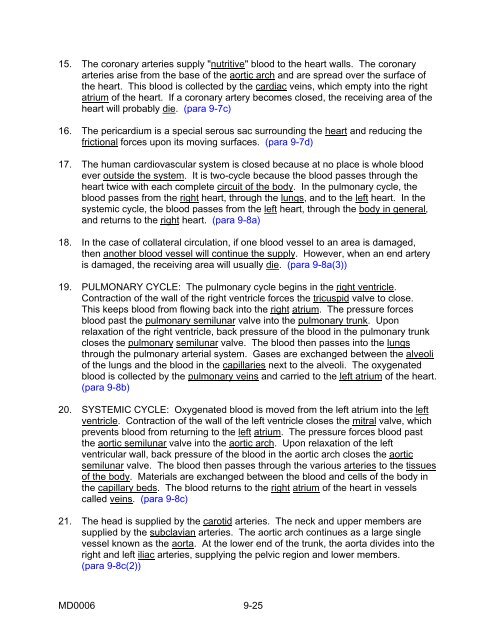md0006 - BASIC HUMAN ANATOMY.pdf - Raems.com
md0006 - BASIC HUMAN ANATOMY.pdf - Raems.com
md0006 - BASIC HUMAN ANATOMY.pdf - Raems.com
You also want an ePaper? Increase the reach of your titles
YUMPU automatically turns print PDFs into web optimized ePapers that Google loves.
15. The coronary arteries supply "nutritive" blood to the heart walls. The coronary<br />
arteries arise from the base of the aortic arch and are spread over the surface of<br />
the heart. This blood is collected by the cardiac veins, which empty into the right<br />
atrium of the heart. If a coronary artery be<strong>com</strong>es closed, the receiving area of the<br />
heart will probably die. (para 9-7c)<br />
16. The pericardium is a special serous sac surrounding the heart and reducing the<br />
frictional forces upon its moving surfaces. (para 9-7d)<br />
17. The human cardiovascular system is closed because at no place is whole blood<br />
ever outside the system. It is two-cycle because the blood passes through the<br />
heart twice with each <strong>com</strong>plete circuit of the body. In the pulmonary cycle, the<br />
blood passes from the right heart, through the lungs, and to the left heart. In the<br />
systemic cycle, the blood passes from the left heart, through the body in general,<br />
and returns to the right heart. (para 9-8a)<br />
18. In the case of collateral circulation, if one blood vessel to an area is damaged,<br />
then another blood vessel will continue the supply. However, when an end artery<br />
is damaged, the receiving area will usually die. (para 9-8a(3))<br />
19. PULMONARY CYCLE: The pulmonary cycle begins in the right ventricle.<br />
Contraction of the wall of the right ventricle forces the tricuspid valve to close.<br />
This keeps blood from flowing back into the right atrium. The pressure forces<br />
blood past the pulmonary semilunar valve into the pulmonary trunk. Upon<br />
relaxation of the right ventricle, back pressure of the blood in the pulmonary trunk<br />
closes the pulmonary semilunar valve. The blood then passes into the lungs<br />
through the pulmonary arterial system. Gases are exchanged between the alveoli<br />
of the lungs and the blood in the capillaries next to the alveoli. The oxygenated<br />
blood is collected by the pulmonary veins and carried to the left atrium of the heart.<br />
(para 9-8b)<br />
20. SYSTEMIC CYCLE: Oxygenated blood is moved from the left atrium into the left<br />
ventricle. Contraction of the wall of the left ventricle closes the mitral valve, which<br />
prevents blood from returning to the left atrium. The pressure forces blood past<br />
the aortic semilunar valve into the aortic arch. Upon relaxation of the left<br />
ventricular wall, back pressure of the blood in the aortic arch closes the aortic<br />
semilunar valve. The blood then passes through the various arteries to the tissues<br />
of the body. Materials are exchanged between the blood and cells of the body in<br />
the capillary beds. The blood returns to the right atrium of the heart in vessels<br />
called veins. (para 9-8c)<br />
21. The head is supplied by the carotid arteries. The neck and upper members are<br />
supplied by the subclavian arteries. The aortic arch continues as a large single<br />
vessel known as the aorta. At the lower end of the trunk, the aorta divides into the<br />
right and left iliac arteries, supplying the pelvic region and lower members.<br />
(para 9-8c(2))<br />
MD0006 9-25
















